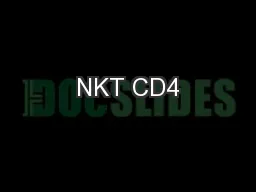

of max DCFDA 12wk 3wk CD44high gated Fig S1 ROS levels in hepatic NKT cells Total hepatic NKT or CD4 T cells left bar graph or CD44high NKT cells right bar graph from 3 or 12 weeks old mice were compared for ROS levels Bar graphs show the summary of 6 mice per group Eac ID: 560978
Download Presentation The PPT/PDF document "NKT CD4" is the property of its rightful owner. Permission is granted to download and print the materials on this web site for personal, non-commercial use only, and to display it on your personal computer provided you do not modify the materials and that you retain all copyright notices contained in the materials. By downloading content from our website, you accept the terms of this agreement.
Slide1
NKT
CD4
% of max
DCFDA
12wk
3wk
CD44-high
gated
Fig. S1
.
ROS levels in hepatic NKT cells.
Total
hepatic NKT or CD4 T cells (left bar graph) or CD44-high NKT cells (right bar graph) from 3 or 12 weeks old mice were compared for ROS levels. Bar graphs show the summary of 6 mice per group. Each flow
cytometry
histogram showed one representative experiment. Error bars represent the mean ± SEM. *p<0.05; **p <0.01.
Supporting informationSlide2
A
NKT
CD4
DCFDA
% of max
20
µ
M DPI
Control
B
% IFN-
g
+
% IL-4
+
% IL-17
+
CD4
NKT
Fig. S2
.
ROS affect hepatic NKT cells function.
(A)
Total lymphocytes from liver of C57BL/6 mice were treated with 20
m
M
DPI for 30 minutes and then measured ROS. The bar graph illustrates the summary of 5 mice per group.
(B)
The cell pretreated with DPI in
(A)
were washed and then stimulated with PMA (50
ng
/ml) and
Inonomycin
(1.5
m
M
) for 5 hours to measure cytokine expression for NKT and CD4 T cells. Bar graphs show the summary of 6 mice per group. Data are representative of at least three independent experiments. Each flow
cytometry
histogram showed one representative experiment. Error bars represent the mean ± SEM. *p<0.05; **p <0.01; ***p<0.001; ****p<0.0001
.
Slide3
ROS-hi
ROS-lo
NKT
TCR-
b
CD1d-tet
DCFDA
% of max
Fig. S3
.
Cell sorting strategy to isolate ROS-low and ROS-high NKT cells. ROS-low and ROS-high NKT cells were sorted from C57BL/6 mice spleens.
Slide4
C57BL/6
V
a
14
Tg
DCFDA
% of max
NKT
CD4
C57BL/6
V
a
14
Tg
Fig. S4
.
Comparison of NKT cells from V
a
14
Tg
and C57BL/6 mice. NKT and CD4 T cells from spleen of V
a
14
Tg
and C57BL/6 mice were compared ROS levels.
Bar graphs on right show the summary of 5 mice per group. Data are representative of at least three independent experiments. Each flow
cytometry
histogram showed one representative experiment. Error bars represent the mean ± SEM. *p<0.05; **p <0.01.
Slide5
CD4
NKT
NKT
CD4
CD62L-lo
DCFDA
% of max
CD62L-hi
Day 3
Day 0
6.89
91.7
29.1
65.4
78.4
18.4
82.6
16.1
CD4
NKT
D3
D0
CD62L
TCR-
b
Fig. S5
.
ROS levels are different in CD62L-low and CD62L-high NKT cells. CD62L-low and CD62L-high splenic NKT and CD4 T cells were compared for ROS levels before (Day 0) and after stimulation (Day 3). Bar graphs show the summary of 5 mice per group. Data are representative of at least three independent experiments. Each flow
cytometry
histograms and dot plots showed one representative experiment. Error bars represent the mean ± SEM. *p<0.05; **p <0.01.
Slide6
B
D
A
C
F
WT
PLZF
+/-
NKT
Annexin
V
% of max
34.4
50.8
% of max
WT
PLZF
Tg
CD4
Annexin
V
45.6
6.46
Spleen
Liver
DCFDA
NKT
CD4
% of max
PLZF
+/-
WT
Spleen
Liver
NKT
CD4
DCFDA
% of max
PLZF
Tg
WT
DCFDA
CD69
PLZF
Tg
-CD4
% of max
Day 3
Day 0
E
LCK-PLZF
CD4-PLZF
NKT
CD4
NKT
CD4
Spleen
Liver
DCFDA
C57BL/6
% of max
Fig. S6
.
PLZF changes the ROS levels.
(A)
NKT and CD4 T cells from PLZF
+/-
and WT mice were examined for ROS levels.
(B)
The same cells used in Fig.
4
A
were treated with 30
m
M
of H
2
O
2
and compared cell death using
Annexin
V.
(C and D)
Cells were isolated from WT or
PLZF
Tg
mice and to compare ROS levels
(C)
and apoptosis
(D)
as done in Fig.
4
A
and
B
.
(E)
Lymphocytes from spleen and liver of C57BL/6, mice expressing
lck
promoter driven PLZF (
lck
-
PLZF), and
cd4
promoter driven PLZF (
cd4
-PLZF) were assessed for ROS level.
(F)
CD4 T cells from
PLZF
Tg
mice were stimulated as in Fig.
3
D
and compared for the amount of ROS measured by DCFDA and the expression of CD69. Histograms are representative of one experiment and at least three independent experiments were performed.